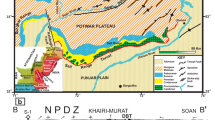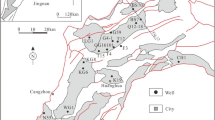Abstract
The analysis of the fractures in the marble forming sierras Blanca and Mijas (southern Spain), with faults of markedly different sizes and joints measured at 21 stations, demonstrate the presence of two principal directions of fractures (NNW-SSE and NNE-SSW). Other major directions of fractures, although less distinct, are N100E, N120E and N60E. The form of the karstic cavities known in these sierras was influenced by fractures, fundamentally NNW-SSE and, to a lesser extent, NNE-SSW, as well as by the mineralogical composition of the marble. All the cavities known are located in blue limestone marble and appear to have formed by the end of the Miocene, principally during the Pliocene and the Pleistocene.
From a hydrogeological standpoint, Sierra Blanca and Sierra Mijas constitute a unit limited by faults oriented ENE-WSW, NNW-SSE and NNE-SSW. Specifically, fractures of the latter two directions influence the compartmentalization and the hydrogeological functioning of the unit.
According to the degree of fracturing and/or karstification, three basic types (apart from intermediate situations) of aquiferous behavior have been distinguished: karstic aquifer, fissured aquifer, and porous aquifer.
Similar content being viewed by others
Author information
Authors and Affiliations
Additional information
Received: 2 October 1995 · Accepted: 29 May 1996
Rights and permissions
About this article
Cite this article
Andreo, B., Carrasco, F. & de Galdeano, C. Types of carbonate aquifers according to the fracturation and the karstification in a southern Spanish area. Environmental Geology 30, 163–173 (1997). https://doi.org/10.1007/s002540050143
Issue Date:
DOI: https://doi.org/10.1007/s002540050143




